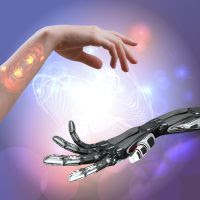Update to the ongoing mission to establish an emotional connection between humans and robots.
Nicholas West
 |
| image source |
As the evolution of humanoid robots continues to quicken, it is forcing the question of whether or not we we will love our robotic overlords. Or, are they not “overlords” at all, but soon to be just part of the family?
Well-known transhumanists such as Ray Kurzweil have made their love affair with robots quite clear, despite some already negative economic impacts that robots are having on their human counterparts. One of the stated missions after all is to supposedly unburden humanity from all of the grunt work.
Beyond the economic and military concerns, the commitment to reverse engineer the human brain coupled with the exponential increase in computing power is forcing the discussion toward the social impact robotics will have. As you will read below, several studies already have been done which aim to assess whether humans can develop true emotional relationships with robots. Some show promise.
Newer robots are being produced with the intention of manipulating emotional triggers by mimicking actions of the human autonomic nervous system – sweating, breathing and even developing goosebumps in response to social situations. It’s all part of a move to make robots seem less creepy and more like real members of society. Researchers are taking multiple angles to establish these connections. This first video is from a new studio in Paris offering the “cute” angle. Meet “Pepper” …
Developing Emotional Bonds Between Humans and Androids
Robots and Artificial Intelligence already have gained some level of interaction with humans, but so far it has been a push-pull between competition and cooperation.
Here are just a few current examples:
- Self-driving vehicles (Source)
- Housesitting: (Source)
- Butlers: (Video)
- Restaurant service (Source)
- Nursing care: (Video)
- Elder care (Source)
- Companionship and Assistance: for pets and people
- Personal Entertainment and Companionship: See ASIMO, and Romeo.
- Teaching (Source)
- Journalism and Writing (Source)
One study set out to discover just how far along we are in human-robot relations. German researchers from the International Communication Association made some revealing discoveries within a group of participants. In order to judge a strict emotional connection, two studies focused on empathy. Would people have empathy for something they knew not to be live being? And would they have the same level of empathy toward both humans and robots?
In the first study, 40 participants watched videos of a small dinosaur-shaped robot that was treated in an affectionate or a violent way and measured their level of physiological arousal and asked for their emotional state directly after the videos.
Participants reported feeling more negative watching the robot being abused and showed higher arousal during the negative video.
The second study used functional magnetic-resonance imaging (fMRI), to investigate potential brain correlations of human-robot interaction in contrast to human-human interaction.
The 14 participants were presented videos showing a human, a robot and an inanimate object, again being treated in either an affectionate or in a violent way.
Researchers found that individuals displayed similar neural activation patterns for affection, indicating that they elicit similar emotional reactions.
However, when comparing videos showing abusive behavior, participants showed more negative empathetic concern for humans. (Source)
 This was a small group of participants, but it would seem that, based on this study, the edge was given slightly to humans.
This was a small group of participants, but it would seem that, based on this study, the edge was given slightly to humans.
However, it is interesting to note that the areas most often cited across the board as targeted for eliminating humans in favor of robotic “assistance” are the very vocations that would seem to require the most empathy:
- Education
- Emergency response
- Helping the elderly and infirm
- Patient rehabilitation
One goal of current robotics research is to develop robotic companions that establish a long-term relationship with a human user, because robot companions can be useful and beneficial tools.
[…]
A common problem is that a new technology is exciting at the beginning, but this effect wears off especially when it comes to tasks like boring and repetitive exercise in rehabilitation. The development and implementation of uniquely humanlike abilities in robots like theory of mind, emotion and empathy is considered to have the potential to solve this dilemma.
Tech site Motherboard posted a cheeky title for one of their articles that might promote some nervous laughter: “To Avoid Your Family, Rent a Robotic Replacement.” A Japanese company has focused on developing a new robot that offers a telepresence for your chosen robotic helper. Instead of rushing home, for example, why not just Skype your new robotic family member and set some tasks for taking care of ailing mom or dad, perhaps the toddler needs to be fed, or the dog needs to be let out 8 pm. While not all of these possibilities are explicitly mentioned or possible for the current model seen in the first video below, we have seen rapid development in the area of humanoid robots. As these robots increase in size, computing power, and a more life-like appearance, they are all but certain to be sold as valid additions to the family.
NEC said it will rental plans for its PaPeRo robot will run as low as less than ¥10,000 per month, which is currently around $100. For that price, the 10 inch, three pound robot will sit around your parent’s house, using its camera, speakers, and facial recognition system to help take your place at home and connect you to people via a conduit that’s more intuitive to interaction than simply leaving Skype running on a laptop on your coffee table.
The main goal appears to be bringing bringing telepresence to the consumer market, and allow people to better connect with each other via robot avatars. The program will first be limited to Japan when it starts early next year, but the company expects to expand worldwide. In its announcement of the partner program, NEC said it’s looking for business partners to develop applications for the bot using NEC’s API and Cloud Federated robot platform.
According to a Kyodo report, “the robot can also be applied to such purposes as managing family members’ schedules as well as detecting suspicious individuals when family members are away from home.”
However, barriers remain toward widespread acceptance, and that is what University of Lincoln researchers have sought to identify. Their project is called ERWIN, a “friendly robot” that who might be able to take humans across the threshold of full acceptance of a robotic presence in our lives.
 ERWIN stands for “Emotional Robot with Intelligent Network” which is an attempt at bridging the gap between the highly rational world of computation and the illogical processes of the human brain that leads to our sometimes unpredictable human-to-human interactions. PhD student and lead researcher on the ERWIN project, Mriganka Biswas, explains the challenges in an interview with The Independent:
ERWIN stands for “Emotional Robot with Intelligent Network” which is an attempt at bridging the gap between the highly rational world of computation and the illogical processes of the human brain that leads to our sometimes unpredictable human-to-human interactions. PhD student and lead researcher on the ERWIN project, Mriganka Biswas, explains the challenges in an interview with The Independent:
When two people interact for the first time, if the two different personalities attract each other, a relationship forms. But, in the case of conventional human-robot interaction, after gathering information about the robot, the robot’s lack of identifiable characteristics and personality prevents any relationship bond developing.
In the attempt to create these human-like “identifiable characteristics,” the team seeks to introduce what one might call “quirks” to ERWIN so that the line between robot and human will not be so severe. Furthermore, the study aims to discover whether a more emotional robot like ERWIN will be preferable to a more humanoid robot with less emotional range:
Alongside ERWIN, the researchers will be looking at the responses people have to another robot, named Keepon. It is non-emotive, but is humanoid in appearance. By comparing how people react to ERWIN and Keepon, the researchers hope to discover which type of robot is more effective in engaging with humans, and which is more conducive to creating a long-term relationship.
As you can see from the video below, ERWIN would never be visually mistaken for a human, and the 5 emotions displayed are rudimentary.
It is likely that neither a completely non-human looking robot like ERWIN, nor a nearly perfect humanoid, but non-emotional robot like the one below will be the solution; for that, emotions will need to be wrapped in the correct skin for true acceptance.
One aspect that some researchers feel has been missing are the emotional cues that come to us via the involuntary actions of the autonomic nervous system. As stated by Graham Templton who has covered new research in Japan: “this team knows that if robots don’t feel human, humans will never start feeling robots.”
What if a robot shivered and even got goosebumps in response to a cold breeze or a scary anecdote? What if you could feel its breath when it spoke, and more violently as the volume increases? What if it would bead with sweat due to heat, or even (fake) emotional stress?
The idea behind these inventions is that we humans are more inclined to trust signals that are communicated involuntarily. So if a robot was to enter your bedroom in the middle of the night and say, “Unknown human detected on the lower floor,” you’d be much more likely to take it seriously if that statement came accompanied by a worried face, heightened breath, and a trembling hand. The emotional timbre of the voice will also be incredibly important; somewhere, someone is writing an algorithm to auto-tune any statement from casual to urgent. (Source)
And this covers everything. Some cybernetics experts even have suggested the possibility for a romantic connection between robots and/or humans by 2045, but this is generally seen as stretching the limits of what is possible. However, it’s not through lack of trying; there can be no doubt about the research taking place that seeks to enhance the current abilities of robotic caregivers and possibly additional family members or lovers.
 There is also a concurrent popularization of robot/human interaction in a more symbiotic way, rather than just as master and servant, which further paves the way toward full acceptance. Japan certainly seems to be at the forefront. We recently saw Obama bowing to a robot in Japan. And Paul McCartney is introducing Newman the robot on his latest tour through Tokyo and Osaka. You can see that strange video here where Newman tours a human museum and establishes a connection with McCartney.
There is also a concurrent popularization of robot/human interaction in a more symbiotic way, rather than just as master and servant, which further paves the way toward full acceptance. Japan certainly seems to be at the forefront. We recently saw Obama bowing to a robot in Japan. And Paul McCartney is introducing Newman the robot on his latest tour through Tokyo and Osaka. You can see that strange video here where Newman tours a human museum and establishes a connection with McCartney.
Perhaps the real question, however, is not how to get robots to act more human but how to keep humans from becoming robots once we can design new companions (or have them designed for us). Is the rise of the robots just a reflection of our own spiritual devolution?
As we look around at our largely selfish, consumer-driven, pharma drug-taking, and increasingly violent society, do we really need more encouragement to shirk our duties toward our fellow companions and family by effectively outsourcing our emotions and responsibilities to the non-living?
If we often stumble throughout meaningful emotional bonds within our own species, will robots really be any type of solution? Or will we really embark on an active path toward eliminating ourselves from the equation entirely?
Other sources:
http://phys.org/news/2013-08-robots-theyre-family.html
Updated: 7/4/2014
Recently by Nicholas West:

Be the first to comment on "Emotional Robots Aim to Become “Man’s New Best Friend”"